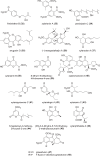Recent progress in biodiversity research on the Xylariales and their secondary metabolism
- PMID: 33097836
- PMCID: PMC7732752
- DOI: 10.1038/s41429-020-00376-0
Recent progress in biodiversity research on the Xylariales and their secondary metabolism
Abstract
The families Xylariaceae and Hypoxylaceae (Xylariales, Ascomycota) represent one of the most prolific lineages of secondary metabolite producers. Like many other fungal taxa, they exhibit their highest diversity in the tropics. The stromata as well as the mycelial cultures of these fungi (the latter of which are frequently being isolated as endophytes of seed plants) have given rise to the discovery of many unprecedented secondary metabolites. Some of those served as lead compounds for development of pharmaceuticals and agrochemicals. Recently, the endophytic Xylariales have also come in the focus of biological control, since some of their species show strong antagonistic effects against fungal and other pathogens. New compounds, including volatiles as well as nonvolatiles, are steadily being discovered from these ascomycetes, and polythetic taxonomy now allows for elucidation of the life cycle of the endophytes for the first time. Moreover, recently high-quality genome sequences of some strains have become available, which facilitates phylogenomic studies as well as the elucidation of the biosynthetic gene clusters (BGC) as a starting point for synthetic biotechnology approaches. In this review, we summarize recent findings, focusing on the publications of the past 3 years.
Conflict of interest statement
The authors declare that they have no conflict of interest.
Figures















References
-
- Blackwell M. The fungi: 1, 2, 3… 5.1 million species? Am J Bot. 2011;98:426–38. - PubMed
-
- Nilsson RH, Anslan S, Bahram M, Wurzbacher C, Baldrian P, Tedersoo L. Mycobiome diversity: high-throughput sequencing and identification of fungi. Nat Rev Microbiol. 2019;17:95–109. - PubMed
-
- Jamy M, Foster R, Barbera P, Czech L, Kozlov A, Stamatakis A, et al. Long-read metabarcoding of the eukaryotic rDNA operon to phylogenetically and taxonomically resolve environmental diversity. Mol Ecol Resour. 2020;20:429–43. - PubMed
-
- Helaly SE, Thongbai B, Stadler M. Diversity of biologically active secondary metabolites from endophytic and saprotrophic fungi of the ascomycete order Xylariales. Nat Prod Rep. 2018;35:992–1014. - PubMed
-
- Hyde KD, Norphanphoun C, Maharachchikumbura SSN, Bhat DJ, Jones EBG, Bundhun D, et al. Refined families of Sordariomycetes. Mycosphere. 2020;11:305–1059.
Publication types
MeSH terms
Substances
LinkOut - more resources
Full Text Sources
Miscellaneous

